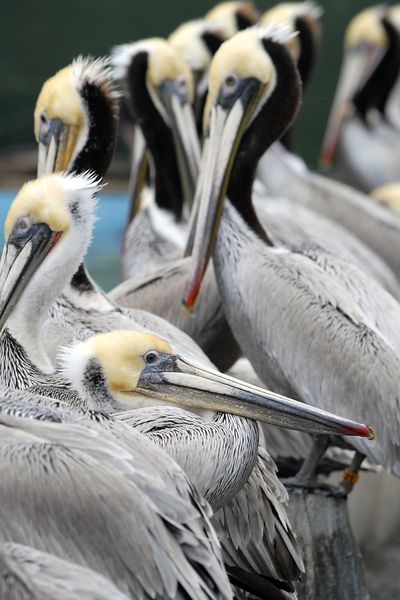Oregon coast swarming with pelicans
Hordes of desperate, starving birds puzzle wildlife experts

ASTORIA, Ore. – All along the Oregon coast over the last month, hundreds of brown pelicans have turned up dead, starving or begging for food.
As many as 1,000 of the gangly seabirds failed to make their annual fall migration to California, many instead winding up at Oregon’s rehabilitation centers.
Those that did head south were battered by California’s recent storms. Shelters in San Pedro and the San Francisco Bay Area too are full of emaciated pelicans.
Researchers, at a loss to explain the casualties, are looking at unusual ocean currents and the depletion of fish stocks – as well as warmer temperatures, toxic runoff and algae blooms – as possible causes.
“In one parking lot, there were people in cars surrounded by pelicans asking for food. We have never seen that before,” said Roy Lowe, project leader for the Oregon Coast National Wildlife Refuge Complex.
In San Pedro, the International Bird Rescue Research Center has taken in about 130 pelicans; a similar number are at the center’s Northern California facility.
“We’ve had unprecedented numbers coming in. Is it some kind of natural die-off? Is it related to some kind of changes in the fish supply? All we know is, we are reaching capacity,” said Paul Kelway of the San Pedro facility.
This is the second year that a large number of pelicans have remained in Oregon rather than trek to the warmer, quieter waters of California and Baja. Between 1918 and 2002, the Audubon Society tallied fewer than 100 pelicans in Oregon every winter. Then the number shot up to 554 birds. In 2008, 3,647 stayed.
This year’s count isn’t in, but experts believe about 3,100 birds remained along the Oregon coast.
“That’s pretty convincing to me that something unusual is going on,” said Deborah Jaques, a wildlife biologist in Astoria who specializes in seabirds.
Decades ago, the seabird population was devastated by DDT, which thinned pelicans’ eggshells. They were listed as endangered in 1970 but rebounded after the United States banned the pesticide in 1972.
Gradually, the pelicans’ summer range crept as far north as British Columbia. With their numbers reaching 650,000 throughout North and Central America, the birds were removed from the endangered species list in November.
Wildlife officials have warned against feeding the birds, which could further injure them – especially since, some researchers say, there may simply be too many pelicans.
“We have lots more birds. So … resources get kind of scarce,” said Julia Parrish, head of a regional seabird survey team. “If there’s a downturn in production in the system for whatever reason, we absolutely know that lots of organisms are going to starve,” she said. “That’s how the ecosystem regulates itself. And it can be pretty ugly.”